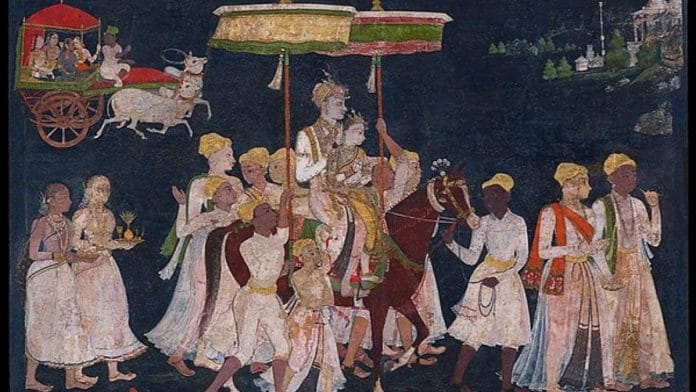No matter which book I dig up, one aspect of Hyderabad’s history always seems to spark debate: the love story of the city’s founder, Muhammad Quli Qutb Shah. In several versions of history, he had a wife named Bhagmati after whom he named my city—or didn’t.
The latest entrant is author Moupia Basu’s new book, Bhagmati: Why Hyderabad’s Lost Queen Is The Soul of the City, which makes a passionate case for Muhammad Quli Qutb Shah’s lover, a dancer/courtesan who the king apparently fell in love with and married. Historians and everyone else who believes in her widely contested existence claim that she was omitted from history books for various reasons.
As someone passionate about exploring Hyderabad’s history, I can’t say that I am convinced about Bhagmati’s existence. But that’s the thing, I don’t need to be, and neither does anyone else. You see, this love story can exist on its own as a side note, because it does not alter Hyderabad’s character in any way.
The legend of Bhagmati
I really wish there were tangible markers of Bhagmati’s existence, but there aren’t any. This is something Basu’s book also unequivocally accepts in spite of making a case for Bhagmati as a central figure in Hyderabad’s history. One needs context to properly understand Basu’s arguments – which I can offer as a contemporary Hyderabadi who’s deeply aware of the city’s roots. I can’t claim to be entirely non-partisan, but I’ll try to be objective.
“Though no historical evidence has been found for Bhagmati’s existence, leave alone her place in the heart of the fifth Qutb Shahi Sultan, few historians, whether professional or amateur, dismiss her completely. While official records make no mention of her, the legend of Bhagmati’s relationship with Quli runs so deep in the soul of Hyderabad that the search for her historical existence will likely continue for as long as the city survives,” reads an extract from Moupia Basu’s book.
It pretty much sums up the relentless scholarly attempts to trace Bhagmati and legitimise her existence. But, as I have argued before in my article for Siasat Daily, where are the physical markers? Even Taramati and Premamati, dancers in the court of seventh Golconda Sultan Abdullah Qutb Shah, are buried in the Qutb Shahi Tombs of Hyderabad. Where’s Bhagmati’s grave, then? There are so many questions, but no answers.
If Muhammad Quli indeed loved Bhagmati and died before her, he should have left something that commemorated her existence, such as a tombstone. This is because it was a common practice among Qutb Shahi royals to build tombs and memorials while they were still alive.
As an oral historian, however, I know historical narratives often don’t leave a physical trace. And I know that people just love to believe in stories, even if they aren’t backed by hard evidence.
Also read: Dear Telangana police, Hyderabad is a youthful hi-tech hub. Stop drug testing partygoers
Nothing changes Hyderabad’s character
Muhammad Quli Qutb Shah laid the foundation of Hyderabad in 1591, as the new capital of the Golconda Sultanate. The city was centred around the Charminar, which is today the emblem of Telangana.
Bhagmati reportedly lived in the village of Chichlam, close to where the Charminar stands. Basu’s book claims that Prince Muhammad Quli was so obsessed with her that his father, Sultan Ibrahim Quli Qutb Shah, built the Purana Pul bridge in 1578 to facilitate his son’s meetings with Bhagmati. The prince was probably in his teens when the bridge was built, so the argument is not entirely convincing. It could very well have been constructed for broader strategic purposes, such as connecting the Golconda Fort with the Old City of Hyderabad.
According to legend and Basu’s book, Muhammad Quli Qutb Shah originally called his new capital Bhagnagar, renaming it Hyderabad when Bhagmati converted to Islam and became Hyder Mahal.
This religious conversion aspect is a little hard for me to swallow, because the Qutb Shahis of Hyderabad were very syncretic in terms of culture. After all, Quli Qutb’s mother was a Hindu woman named Bhagirathi, while his Muslim father was known to be a connoisseur of Telugu literature. As I have written before, the name Hyderabad is likely derived from ‘Hyder’. It’s one of the names of Imam Ali, the cousin and son-in-law of Prophet Muhammad, whom Shia Muslims also follow. And the Qutb Shahi Sultans were ‘orthodox’ Shias.
Basu also brings in the angle of Bhagmati being a Devadasi (women attached to temples as servants of Gods), who was omitted from history due to her caste. If this is indeed true, then their relationship is a shining example of how love transcends everything.
Of course, let’s not forget that a section of people do not want to accept the love story mainly due to religious motivations. While I am not really interested in addressing that, there’s no denying that Basu’s book will be an addition to their arsenal.
Accepting the love story of Bhagmati and Muhammad Quli Qutb Shah fulfils no one’s political interests. The idea of a Muslim king falling head over heels for a Hindu woman is not something Right-wingers may want to support, after all. Be that as it may, I would maintain that the story of Bhagmati’s existence is inconsequential to Hyderabad today.
With or without it, Hyderabad would have been the great city it is. My city is one that anyone can make their own. All you have to do is love and accept it.
Yunus Lasania is a Hyderabad-based journalist whose work primarily focuses on politics, history and culture. Views are personal.
(Edited by Zoya Bhatti)







her existence is purely a myth as there are other characters out these… nothing real… as well, what was the age of quli when the bridge was built?